Export prices for logs and sawnwood remain stable. The
doubts expressed by exporters in August and September
this year that the prices being obtained for certain species
were likely to fall back to the previously established levels
did not materialise.
2.
GHANA
Export permits drop by a third in July-September period
A total of 1,235 export permits were processed, approved
and issued by the Timber Industry Development Division
(TIDD) during the third quarter, covering shipments of
timber and wood products through the ports of Takoradi
and Tema, as well as overland exports to neighbouring
ECOWAS countries.
The Table below summarises the number of export
permits issued by product during the second and third
quarter of 2011.

The number of permits issued in the third quarter declined
by almost 30% compared to the previous quarter.
The number of permits issued in Kumasi fell drastically
from the previous quarter figure of 622 to just 155. This,
say local analysts, could be due to the TIDD exercise of
eliminating chainsaw lumber exports which go mainly to
neighbouring countries.
The number of permits issued for Kumasi shipments to
neighbouring countries dropped from 519 in the second
quarter to 54 in the third quarter.
The highest number of export permits issued was for
sawnwood shipments which accounted for 45% of the
total number of export permits issued during the quarter
under review. Permits for plywood export were the second
highest.
Regional, Middle East and Asian markets sustain price levels
During the third quarter of this year the TIDD processed
and approved contracts for the exports of sliced veneer,
mouldings and celtis sawnwood meant for the West
African market.
Mouldings produced from species such as wawa, koto,
otie, utile, ofram and walnut were shipped to Nigeria.
Contracts for exports of sliced veneer to the Ivory Coast
and celtis sawnwood for Senegal were approved.
During the third quarter exporters were able to meet the
Minimum Guiding Selling Price (GSP) for plywood
destined for the West African market, especially Nigeria.
Most export contract prices were well above the GSP. The
TIDD data shows that prices for wawa sawnwood
contracts for Far and Middle East countries improved from
levels recorded recently.
Firm demand at low prices an issue in the US market
In contrast, exporters of mahogany sawnwood to the US
market were, with a few exceptions, unable to satisfy the
GSP. The gap between the contract price and the GSP in
the second quarter was around 3-7%. However, in the third
quarter the difference between the price being offered by
US buyers and the Ghana GSP widened to 7-11%.
Ghana¡¯s under utilised species such as celtis, yaya and
denya continued to find markets in the Middle and Far
East countries. Shorts of denya sawnwood continue to
attract buyers for the Chinese market.
Ghana¡¯s exports to the US boosted by African Growth
and Opportunity Act
Ghana¡¯s exports of all products to the US doubled during
the period September 2010 to September 2011 according
to the US International Trade Commission (USITC) which
uses statistics data provided by the US Department of
Commerce to compile country reports.
This performance was aided by the US ¡®African Growth
and Opportunity Act¡¯ (AGOA). The data show that
Ghana¡¯s export under the AGOA (including the GSP)
increased from US$31.1 mil. September 2009- 2010 to
US$195.7 mil. over the same period up to September
2011.
Ghana¡¯s main exports to the US market comprised
agricultural products, forest products, textiles and apparel.
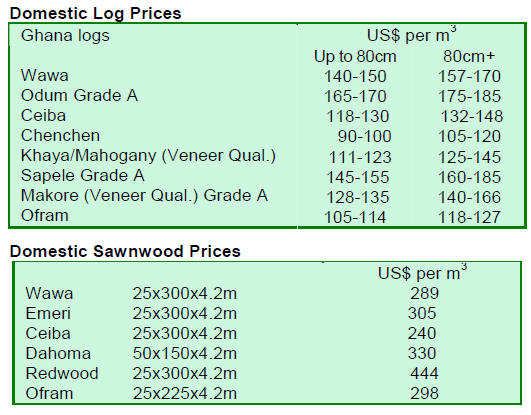
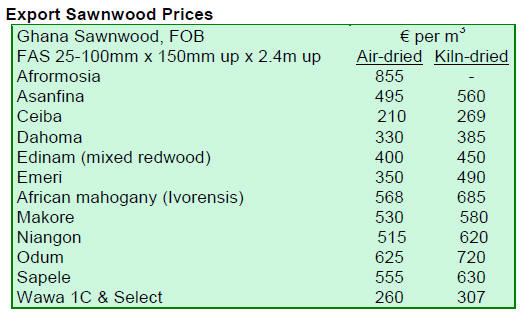
3.
MALAYSIA
Investment in furniture production will bring
substantial benefits to Sarawak
The Ministry of International Trade and Industry is urging
the timber sector in Sarawak, as the state with the largest
timber resource, to consider expanding investment in the
furniture industry. This, says the Ministry, could lead to a
higher return on investments.
The Ministry added that, while Malaysia exported RM8
billion worth of furniture in 2010, Sarawak¡¯s share was a
mere RM20 million of the total.
The Sarawak Timber Industry Development Corporation
(STIDC) hoped that its planned establishment of extensive
plantations will provide resources for the furniture
industry in Sarawak to take off.
Risk of credit squeeze looms in Malaysia and across Asia
According to Nomura International (Hong Kong) Ltd, the
Malaysian economy is expected to recover in the second
half of 2012 and fourth quarter 2012 growth of up to 7.3%.
Growth in the third quarter 2011 is projected at 5.8% and
fall to around 4% in the final quarter of the year.
The exposure of Malaysian banks to European banks
reportedly stood at US$50 billion in June 2011 excluding
investments by HSBC and Standard Chartered baks, both
of which have significant operations in Malaysia.
European banks with large overseas exposure may tighten
credit lines and lessen their exposure in Asia which could
lead to tighter credit conditions and net capital outflows
from Asian countries.
Government spending led growth may be
unsustainable in the long term
The current GDP growth achieved in Malaysia was driven
by public sector investment with one-third of this coming
from direct government spending. This, say analysts is
unsustainable in the long term.
As a result there is not much room for expansionary fiscal
policy in Malaysia for 2012 due to the relatively high
public-debt-to-GDP ratio of 55%, the second highest in
Asia.
The outlook for the Malaysian timber industry in 2012
remains uncertain as prices of timber and wood products
remain weak mainly because of poor housing starts in
major export markets.

4.
INDONESIA
Risk of dispute looms peatland boundaries are
adjusted
Indonesia is revising the boundaries of the peatland
defined in the moratorium agreed with Norway. Reports
suggest that some 4.8 million ha. of peatland will be
removed from the area of 10.7 million ha. previously
defined as protected in the original moratorium.
Compounding the chances of a dispute on areas covered
by the moratorium is the decision by the Governor of
Aceh province to allow an oil palm plantation to be
established in an area which, say opponents, is a protected
peatland.
Weak global demand for Indonesian products will
eventually affect Indonesian domestic economy
The housing markets in major timber importing countries
continue to weaken and the EU debt crises continues to
bear upon international trade opportunities. These factors,
amongst others, are causing export prices for Indonesian
timber products to spiral downwards reaching their lowest
in 2011.
While the Indonesian domestic economy has remained
stable, analysts are of the opinion that it will not be long
before the weak global demand for Indonesian products
begins to affect the local economy.
Exporters call for aggressive timber export
promotion
Indonesian timber exporters have expressed the view that
there is a need for the timber industry and Indonesian
government to formulate strategic programmes to boost
the export of timber products.
Some timber exporters added that, while there are
ongoing
efforts, more aggressive programmes and planning are
needed to cushion and safeguard the Indonesian timber
industry in the short-term while solutions to the US and
EU debt crises are negotiated.
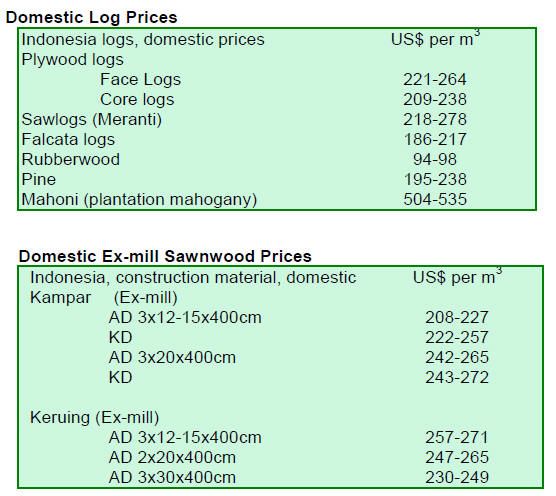
5. MYANMAR
2011 has not been a very good year for the
Myanmar
timber industry
In reviewing the year analysts say, compared to 2010,
2011 was not a very good year for the timber trade.
While demand for teak held up reasonably well,
demand
for pyinkado was very weak throughout the year.
Prices for pyinkado started to show signs of
weakness in
late 2010 and this continued throughout 2011.
Analysts say the price levels for pyinkado are set
too high
and do not reflect current interest in this timber or the
economic realities in the importing countries.
Another factor which disrupted trade was the
weather.
Early rains in April this year made transportation of logs
difficult and caused a supply shortage in the Yangon log
yards.
The market for lower priced gurjan (kanyin) logs,
which
was not active during 2010, made a slight recovery in the
second quarter only to weaken again in September and
October.
The slowdown in western economies has had a negative
impact on the demand from countries importing timber
from Myanmar.
Few prospects for a quick market turn-round
Demand in India, a major buyer of timber from Myanmar,
has been affected largely by the rapid depreciation of the
Indian rupee.
India is a main market for teak from Myanmar and in
this
market demand for teak began to weaken during the
second half of the year. As the year is about to come to an
end there are few prospects for an early recovery in
demand for teak, pyinkado and gurjan.
CIFOR statistics illustrate strength of demand
for logs in India
Myanmar¡¯s Central Statistical Organisation data reports
the export of logs from January to December in 2010 as
237,100 cubic tons of teak and 681,500 cubic tons of
hardwoods. The figures for the period January to
September 2011 are 185,400 tons of teak and 572,400 tons
of hardwoods.
Figures compiled by CIFOR for the year 2010 showed
China bought 0.4 million cu.m of logs valued at US$ 0.14
billion CIF and 0.1 million cu.m of sawnwood valued at
US$0.05 billion CIF from Myanmar. India¡¯s imports were
stated at 0.8 million cu.m of logs valued at US$0.31
billion CIF.
December teak log sales for local millers
concluded
The following are the results for tender sales of teak logs
for the local industries held on 9 December 2011.
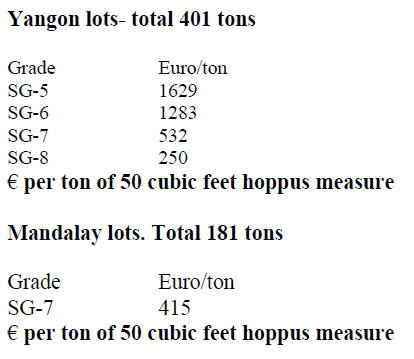
Dates for December open tender for teak
The Myanmar Timber Enterprise open tender teak log
sales for December will be held on the 16th and the 19th of
this month.
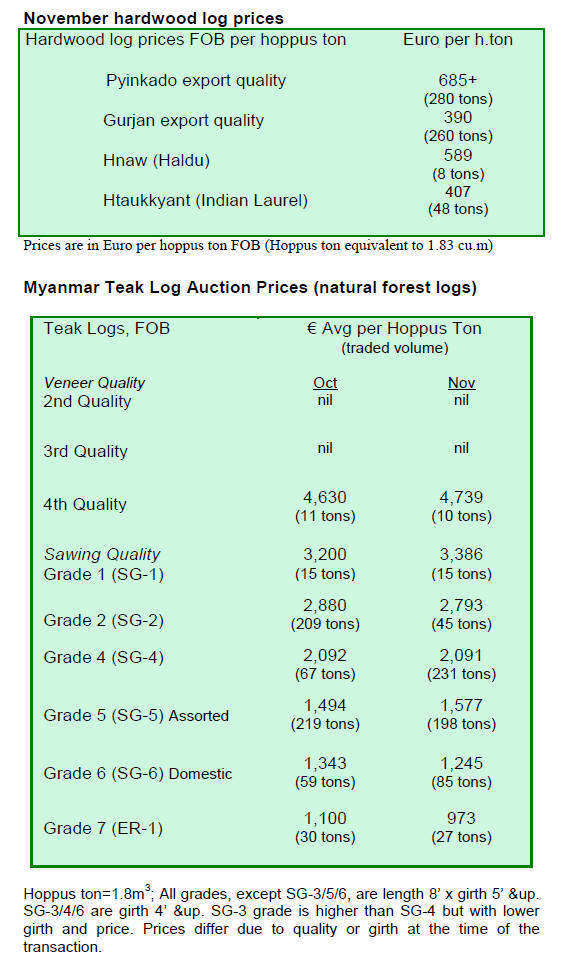
6.
INDIA
Global economic downturn affecting
the Indian economy
India¡¯s GDP fell to a two year low of 6.9 percent in the
second quarter of this financial year, slipping below 8%
for the third straight quarter. The economy grew 8.4%
during the corresponding quarter of last year.
Simultaneously, the Indian rupee suffered its worst
decline
against the US dollar in 16 years. In November the
currency plunged almost 7 percent, pushing the
downward trend to over 14 percent for the year to date.
Dollar demand from importers and financial outflows,
as
investors reacted to growing risks, caused the slide. The
government and the Bank of India are acting to arrest this
situation and stabilise the rupee exchange rate.
Real estate sector performance slows
Analysts suggest that the shadow of the global economic
weakness will dent India¡¯s growth figures for a while.
The focus of domestic manufacturers will shift from
consumer demand in the mega cities such as Mumbai and
New Delhi to other newly developed cities.
Government investment in rural development projects
holds a better promise for industry than the weakening
demand in the traditional urban domestic markets.
Boom and bust swings in demand are a common
phenomenon and this provides an opportunity for the
industry to attend to production and distribution
weaknesses and to improve performance by delivering
higher quality products and better services.
The emerging so-called ¡®integrated townships¡¯ are
where
the future of India¡¯s manufacturing sector will be in the
future say analysts. The global economic weakness and the
undermining of consumer confidence have put a brake on
consumption by consumers in the high-end domestic
market.
The timber industry has to turn to the affordable
home
segment which was not given much attention while the
overall real estate market was booming. Housing demand
from middle and lower income groups will probably be the
driving force for the manufacturing industry from 2012
onwards.
Smugglers of Red Sanders become violent
Forest officials and wardens are facing increased violence
from timber smugglers.
The unresolved case of the death of a forest officer
in
Andhra Pradesh, the main producing area for red sanders,
is thought to be caused by the action of gangs stealing this
timber. This is the first time that a forest officer has been
killed pursuing thieves.
It is estimated that approximately 2,000 tons of
this
precious wood is being smuggled to other Asian countries
for the manufacture of herbal medicines, special musical
instruments and cosmetics.
In 2010-2011, 1,591 persons were arrested and a
total of
1,290 tons of red sanders was seized.
First hardwood auction in the Central Province
fetches
good prices
Harda, Jabalpur, Hoshangabad and Betul Forest Division
depots have just completed the first post Deewali auctions
for the current season and the dates for sales during
December have been set.
Approximately 20,000 cu.m of teak logs and 14,500
cu.m
of other hardwoods as well as bamboo and teak poles will
be sold at the upcoming auction.
At the recently concluded auction good demand
resulted in
high average prices for teak logs as shown below.
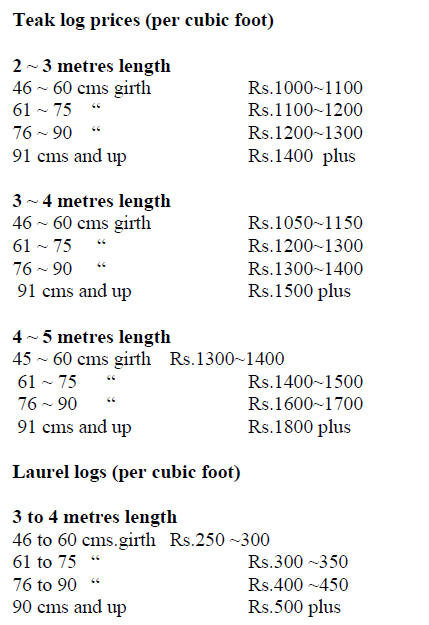
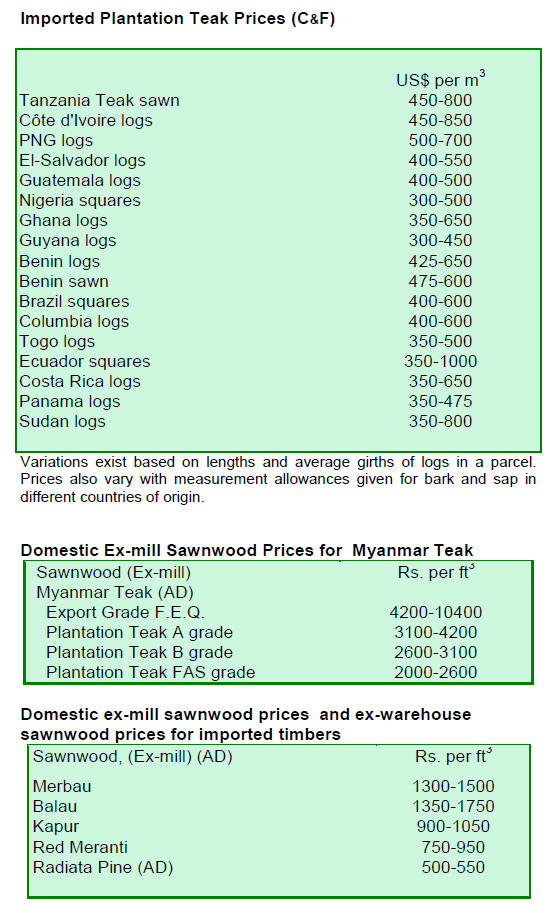
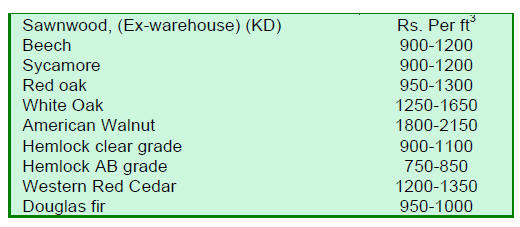
7. BRAZIL
Furniture hub in Cruzeiro do Sul attracts
investors
The establishment of an industrial hub in Cruzeiro do Sul
in the Amazon State of Acre is almost complete. The Acre
State government has invested about R$3 million in the
development of this industrial centre.
This investment, specifically for the wood
processing
sector, has attracted the attention of entrepreneurs from
other States.
Many industrialists are keen on this initiative in
Acre as
the state has two strategic road connections, one is
highway BR-364, which helped inter-state integration and
another is the convenient connection to ports on the
Pacific coast via the Trans-oceanic highway.
This new development makes Acre an attractive
location
for industrial development and new wood processing
operations are expected to open at the industrial hub.
The timber industry in Acre benefits from support
for its
operations, with its raw material supply is guaranteed legal
since it comes from community and publicly managed
forests or from private land covered by management plans.
Representatives of manufacturers in the hub are
appreciative of the investment by the state government and
the efforts of the government to invest in an industrial
sector.
Bright long term prospects for wood product manufacturers
Despite the current global economic downturn, countries
with primary raw material production capability have a
secured future. This has prompted the Brazilian Senate to
review the country¡¯s long term export strategy.
Analysts suggest that, taking account of global
trends, the
forestry and timber industries will have a bright future in
the coming years.
In September, Brazilian exports of wood products
were
valued at US$155 million, representing a 6.7% decline on
the previous month. Imports of wood products were
US$17 million, a sharp drop of 14.4% from the previous
month.
In order to be well prepared for the eventual
improvement
in global demand parliamentary initiatives, aimed at
creating the conditions for investment in added value
production, are said to offer prospects for a sound future
for the sector in the medium to long-term.
There is a proposal being considered by the
Brazilian
senate for a ban on the export of unprocessed wood. This
measure, if adopted, should encourage greater investment
in wood processing which, in turn would create more jobs
and increase export earnings.
Furniture output grows despite uncertainties in
global economy
The Brazilian furniture industries are worried that the
uncertainties in the global economy, mainly caused by the
crisis in the euro-zone countries, will continue to depress
demand. In addition exchange rate fluctuations have
resulted in Brazilian wood products loosing international
competitiveness.
Despite the international crisis, the furniture
sector
achieved positive growth in August mirroring trends in the
overall Brazilian processing industries. Furniture output in
August increased 12% compared to levels in August 2010.
However, furniture exports have been falling. For
the year
to-date Brazil¡¯s furniture exports were around US$337
mil., 12% lower than in the same period in 2010.
In contrast furniture imports have been growing due
mainly to the strength of the real. From January to August
2011, imports climbed 97% higher than in the same period
in 2010. However, in September there was a significant
drop in the level of imports reflecting the sharp
depreciation of the Brazilian real against the US dollar.
Measures by the federal government to assist the
furniture
sector such as investment in promotion, lowering interest
rates, and other measures to boost domestic demand
helped the furniture sector.
Wood Identification System could raise tax
revenues to state
The Mato Grosso Institute of Agricultural Protection
(Indea) participated in the First Wood Anatomy and
Identification Seminar in the Amazon, in Bel¨¦m, Par¨¢. The
main objective was to exchange experiences on the
establishment of wood anatomy and identification systems
and log scaling in the Amazon region.
In 2009, when the latest survey was conducted,
there were
71 wood processing centres in the Amazon region. These
centres were logging approximately 14.2 million cubic
metres annually. The states of Par¨¢, Mato Grosso and
Rondônia were the largest producers. Estimates of the
gross revenue generated by the Amazon timber industry in
that year were around R$4.9 billion.
Cost effective systems for anatomical
identification of
species is considered the most reliable means to ensure
that consumers receive the species they require. Correct
specie identification is also a tool to value products an
element in the process to secure certification from state
agencies.
If an easy to use wood identification system can be
developed it could, say analysts, result in higher state
timber tax revenues and help in protecting controlled
species as well as improving consumer protection.

¡¡
8. PERU
Peru¡¯s GDP growth may exceed
forecasts
Official data from the national authority, SUNAT, reveals
that the value of Peru¡¯s exports in the first 10 months of
the year rose by more than a third compared to levels in
the same period in 2010.
Analysts report that exports of traditional
products grew
by 75% while the so-called non-traditional exports grew
over 20%.
Foreign exchange earnings were derived mainly from
agricultural products, the oil and gas industries, the mining
sector (copper and gold) and the fisheries sector.
Economists are painting a rosy picture of prospects
for the
country¡¯s GDP growth suggesting that growth in 2011
could exceed government forecasts.
Peru stands to gain from Economic Partnership
Agreement with Jjapan
The Economic Partnership Agreement with Japan, which
was signed earlier this year, has been ratified and analysts
point out that this will benefit the textile and clothing
sectors as well as the forestry, agriculture and fishing
sectors.
This agreement provides for reduced tariffs on
Peruvian
products. Similarly, Peru will also benefit from
competitive Japanese products. From 2012 Peru will have
operational trade agreements with two of worlds the
largest economies namely Japan and China.
For more see www.andina.com.pe
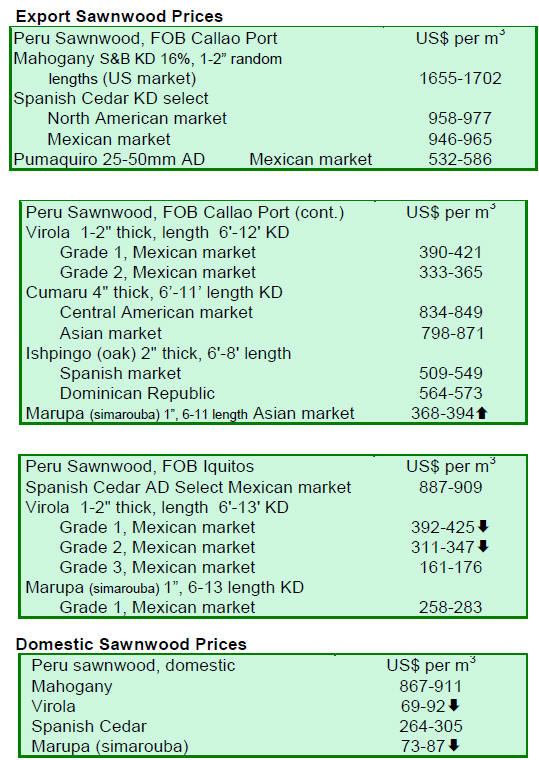
¡¡
9.
GUYANA
Mora and purpleheart logs
are the current favourites in
export markets
The weakness in demand for greenheart logs continues
and there were no exports of this product during the period
under review. Demand in the local market is stable and
there is continued processing of greenheart logs into added
value products to satisfy the housing market.
On the other hand, purpleheart logs are in demand
in
export markets and prices are favourable for all log
categories. The current price levels are higher than those
in the previous period of review.
Mora logs are also in demand and this translated
into
attractive and improved prices for all log categories
compared with levels in the previous period.
Firm European demand for sawn greenheart
surprises the trade
While demand for greenheart logs is weak the situation is
different for greenheart sawnwood. Undressed greenheart
sawnwood attracted good prices and rather surprisingly,
there was firm demand from major buyers in Europe,
Guyana¡¯s main market for greenheart.
Overall, prices for undressed greenheart sawnwood
are
holding for all categories except merchantable.
After a quiet period, undressed greenheart prime
quality
was in demand again on the export market and good prices
of US$ 800 per cubic metre were secured.
Select quality undressed greenheart was exported at
prices
from US$636 to US$806 per cubic metre, up on levels in
the previous period. On the other hand, exporters report
that prices for undressed greenheart sound quality fell
from US$1,509 to US$1,399 per cubic metre.
Prices for undressed purpleheart select quality
remain
unchanged while undressed Mora sawnwood prices were
favourable during this fortnight period with export demand
for all categories except prime quality.
During the period under review dressed sawn prices
were
mixed. Dressed greenheart prices fell at the top of the
range from US$1,350 to US$996 per cubic metre.
Dressed purpleheart prices, on the other hand, rose
significantly from US$912 to US$1,060 per cubic metre
for this period in comparison to the previous period.
Guyana washiba (ipe) in the form of dressed
sawnwood
attracted a remarkable price average of USD 2,500 per
cubic metre.
Guyana plywood was shipped to destinations in the
Caribbean and South America at prices as much as
US$600 per cubic metre.
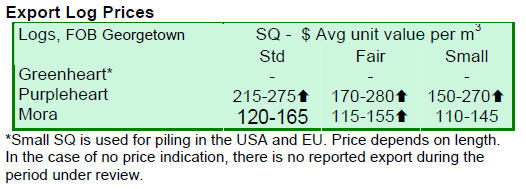

Guyana¡¯s forestry sector falls under New
Ministry of Government
Following the 2011 elections in Guyana the Ministry of
Natural Resources and Environment responsible for the
forestry and mining sectors in the country has been
established.
The new ministry is currently headed by the former
Minister of Agriculture Mr. Robert Persaud and seeks to
harmonise policies in key areas of environment and
natural resources so as to increase development within the
natural resources sector.
This new ministry will be addressing a number of
issues
related to mining, environment, climate change and
forestry. Guyana has been actively engaged in
international dialogue to ensure and promote legal timber
production and sustainable forest management and work
on this will be enhanced.
Progress on the implementation of the Guyana
Legality Assurance System
The Guyana Legality Assurance System framework falls
within the mandate of the new ministry in maintaining the
legality aspect within forestry.
The Guyana Legality Assurance System has recently
undergone rigorous review/audit by international bodies to
assure its transparency and acceptance internationally.
A progress report on the implementation of the
system was
recently handed to the then Minister of Agriculture (now
the new Minister of Natural Resources and the
Environment). Implementation of this system is expected
to make further progress in 2012.
Related News: